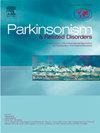左旋多巴的附加疗法改善帕金森病伴运动波动的疼痛调节:一项前瞻性队列研究
IF 3.4
3区 医学
Q2 CLINICAL NEUROLOGY
引用次数: 0
摘要
背景:疼痛是帕金森病(PD)中一种常见但常被低估的非运动症状,影响生活质量(QOL),并常与运动波动相关。虽然PD疼痛的病理生理机制尚不清楚,但大多数假设涉及多巴胺能和非多巴胺能途径。目的评价MAO-B和COMT抑制剂作为左旋多巴的附加疗法,对伴有运动波动的PD (pwPD)患者疼痛阈值的影响,无论是否伴有疼痛。方法本前瞻性队列研究招募了40名患有运动波动的pwPD患者,他们开始服用selegiline, rasagiline, safinamide或opicapone。疼痛阈值(触觉、疼痛和耐受性)在基线和3个月和6个月后通过电刺激进行评估。收集11名健康受试者的规范资料。结果测量pwPD目标运动障碍(UPDRS)、疼痛感知(King’s PD疼痛量表)、情绪、疲劳、睡眠和生活质量。结果spwpd组的触觉阈值高于对照组,疼痛阈值和疼痛耐受阈值低于对照组。6个月时,与奥匹卡彭相比,雷沙吉兰和沙非胺均显著改善了疼痛阈值和耐受性。疼痛在女性中更为常见,并与焦虑、睡眠质量差和运动并发症有关。回归分析显示,认知状态、性别、病程、年龄、焦虑水平和MAO-B抑制剂治疗是疼痛加工的关键调节因子。结论pwPD患者疼痛加工发生改变,与主观疼痛主诉无关。MAO-B抑制剂,特别是沙非胺和雷沙吉兰,似乎可以恢复疼痛阈值并改善生活质量,支持它们在PD患者疼痛管理中的作用。本文章由计算机程序翻译,如有差异,请以英文原文为准。
Add-on therapies to levodopa improve pain modulation in Parkinson's disease with motor fluctuations: A prospective cohort study
Background
Pain is a common and often underestimated non-motor symptom in Parkinson's disease (PD), affecting quality of life (QOL) and frequently associated with motor fluctuations. Although the pathophysiological mechanisms underlying pain in PD remain unclear, most hypothesize the involvement of dopaminergic and non-dopaminergic pathways.
Objective
To evaluate the effect of MAO-B and COMT inhibitors, used as add-on therapies to levodopa, on pain thresholds in people with PD (pwPD) with motor fluctuations, either with or without pain.
Methods
This prospective cohort study enrolled 40 pwPD with motor fluctuations who were started on selegiline, rasagiline, safinamide, or opicapone. Pain thresholds (tactile, pain, and tolerance) were assessed using electrical stimulation at baseline and after 3 and 6 months. Normative data were collected from 11 healthy subjects. Outcome measures in pwPD targeted motor impairment (UPDRS), pain perception (King's PD Pain Scale), mood, fatigue, sleep, and QOL.
Results
PwPD showed higher tactile thresholds and lower pain and pain tolerance thresholds than controls. At 6 months, both rasagiline and safinamide significantly improved pain thresholds and tolerance compared to opicapone. Experiencing pain was more frequent in women and was associated with anxiety, poor sleep, and motor complications. Regression analyses revealed that cognitive status, sex, disease duration, age, anxiety levels and treatment with MAO-B inhibitors were key modulators of pain processing.
Conclusion
Pain processing is altered in pwPD, independently of subjective pain complaints. MAO-B inhibitors, particularly safinamide and rasagiline, appear to restore pain thresholds and improve QOL, supporting their role in managing pain in PD.
求助全文
通过发布文献求助,成功后即可免费获取论文全文。
去求助
来源期刊

Parkinsonism & related disorders
医学-临床神经学
CiteScore
6.20
自引率
4.90%
发文量
292
审稿时长
39 days
期刊介绍:
Parkinsonism & Related Disorders publishes the results of basic and clinical research contributing to the understanding, diagnosis and treatment of all neurodegenerative syndromes in which Parkinsonism, Essential Tremor or related movement disorders may be a feature. Regular features will include: Review Articles, Point of View articles, Full-length Articles, Short Communications, Case Reports and Letter to the Editor.
 求助内容:
求助内容: 应助结果提醒方式:
应助结果提醒方式:


